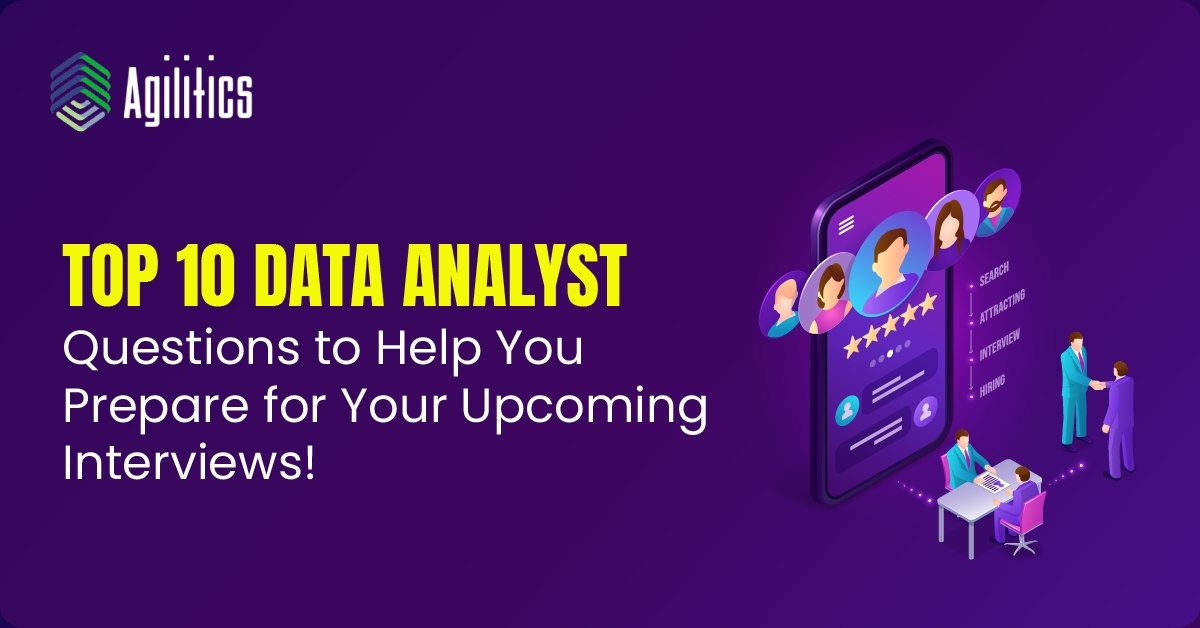If you are planning to take a career in data analytics, you must be wondering what all it involves. In fact, being a Data Analyst is a very rewarding job. It does require you to work with huge volumes of data with the sole objective of finding some patterns for your company’s betterment. However, if you have an analytical mind and the will to learn about data analytics you are likely to enjoy this job more than any other.
So if you are planning to pursue your career as Data Analyst, Agilitics has here designed some of the top interview questions to help you prepare for the interview:
What roles do a Data Analyst have?
The Data Analysts have the following roles:
- Collecting data from a variety of sources and analyzing them,
- Filter the useful data and “clean” the unwanted data from a variety of sources
- Assist with all aspects of data analysis
- Uncovering hidden patterns by analyzing large datasets
- Maintaining database security
What are the best data analysis tools?
There are many data analysis tools. However, to name a few, below are some of the best data analysis tools:
- Tableau
- Qlik
- RapidMiner
- KNIME
- Apache Spark
- SAS
- Looker
- Google Analytics
- Open Refine
- NodeXL
What is data mining?
Data mining is the science of analyzing data from different perspectives in order to extract useful information, knowledge, and patterns. Data mining is an interdisciplinary subfield of computer science drawing on concepts and methods from many fields, such as artificial intelligence, machine learning, statistics, and database systems.
What are the commonly used data validation techniques used by data analysts?
The most commonly used data validation techniques used by Data Analysts are:
- Form level validation
- Field level validation
- Search criteria validation
- Data saving validation
What do you know about outliers?
Outliers are values that appear in the measurement of a data set but do not follow the pattern that most of the data follows. One way to detect outliers is to use a visual technique, such as box plots or error bars, where any points that fall outside of the expected range can be easily identified and visually distinct from the majority of the data set.
Describe the process of data analysis?
Data analysis is the process of accumulating, cleaning, analyzing, manipulating, and modeling data to derive insights or conclusions and provide reports to assist organizations in becoming more lucrative. Data analysis is performed by business analysts, researchers, statisticians and consultants from inside businesses as well as financial institutions (e.g., banks, credit unions). The steps involved in the process are:
Collect Data: Before any analysis can begin, data must be collected and stored. Raw data is collected and stored in databases. That information is then cleaned and prepared for use in the next step.
Analyze Data: In order to obtain accurate and valid results from statistical models, information must be collected correctly and completely. Once the model has been created, it must accurately show the relationship between independent and dependent variables. It is good practice to build the model multiple times using different data sets in order to validate it.
Create Reports: The last step involves implementation of the model and then generating reports from the data collected and analyzed and distributing them to stakeholders.
What is data cleansing?
Data Cleaning, also known as Data Scrubbing, is an essential part of data scrubbing and trend analysis. It is the process of identifying incomplete and inaccurate records and then taking the necessary steps to correct, replace or remove the incorrect data. In order to ensure that your data is completely trustworthy and of the highest possible quality, it is vital that you implement a Data Cleaning service into your company’s business intelligence strategy.
Explain data profiling
Data profiling is the process of examining data, objects, and responses to determine information such as data type, frequency, missing values, and distribution. Data profiling involves a collection of tools that provide information on data attributes and the structure of tables, queries and databases. The main objective of data profiling is ensuring data integration between heterogeneous systems. Data profiling primarily focuses on enterprise metadata which includes business rules and regulations about the data.
What are the different Python libraries used in data analysis?
- TensorFlow
- NumPy
- Matplotlib
- Bokeh
- SciPy
- Pandas
- SciKit
- Pandas
- Keras
- PyTorch
What is the definition of Logistic Regression?
Logistic regression is the primary tool used to analyze the relationship between independent variables and a categorical dependent variable. The input of independent factors or predictors transform into categorical-type output through a logit function.
Conclusion
Over the past year, data analysis has become a major part of how companies view and interpret their information. By combining business needs with technical expertise, many companies today are able to make more informed decisions regarding their data than ever before.
Any organization, whether it be small or large and regardless of its focus or mission, can benefit from the insights that data analysis can provide. Hopefully with these materials, you will have an easier time understanding and gaining insights from data as well.
We strive to provide business professionals with the skills and knowledge necessary to increase work performance and drive greater return on investment for the global customers we support. Agilitics delivers customized technology and management training solutions to large corporations and government agencies around the world.


